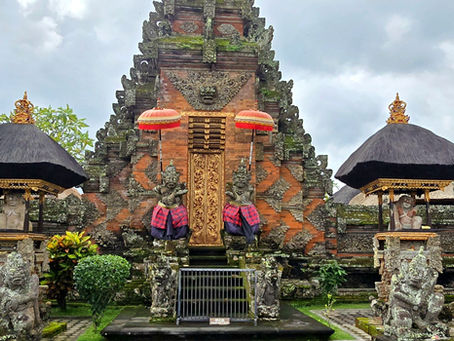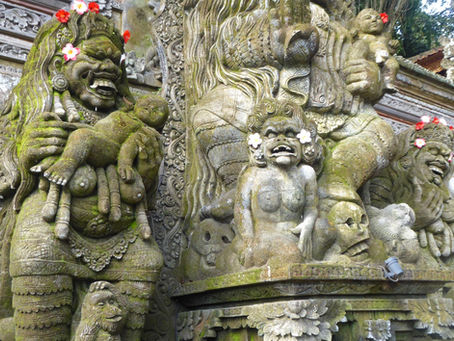top of page

GLOBAL SHANANIGANS

Search


The Royal Palace of Ubud
In the heart of Ubud, the Royal Palace stands as a stunning showcase of Bali’s rich history and artistic spirit. Built around 1640, this elegant complex of pavilions and gardens offers a glimpse into the lives of the island’s royal family while pulsating with cultural performances and traditional ceremonies that keep Ubud’s heritage alive.
Shannon


Bali’s Buried Past - Blood on the Island of the Gods
One of the most horrific chapters in Balinese history occurred during the anti communist purges which swept across Indonesia in the mid 1960's and barely anyone dares talk about it. In the years leading up to the massacre, Bali was already a fractured island, mirroring the deepening political and social divisions across Indonesia.
Shannon


Taman Ayun - The Royal Playground
Encircled by a wide moat and wrapped in manicured geometric gardens, Pura Taman Ayun looks more like a mythical vision than a temple. This 17th-century royal fortress served as the royal temple of the once mighty Mengwi kingdom and was designed not just to honour the gods but to remind subjects of the divine order that placed kings just beneath them.
Shannon


Vihara Dharmayana - The Dragon Pagoda
Established in 1876, Vihara Dharmayana stands as one of the oldest Buddhist temples in Bali and the only one of its kind in Kuta. Known locally as Kongco Kuta, the temple was built to honour Tan Hu Cin Jin, a Chinese nobleman and architect who served the King of Mengwi. The site was famously visited by the 14th Dalai Lama during his tour of the island in 1982.
Shannon


Kehen - The Temple of Fire
First mentioned in ancient copper inscriptions from the 9th century, Kehen Temple was originally known as Pura Hyang Api, a sacred site dedicated to Agni, the Hindu God of fire. This powerful deity symbolises not just destruction but also renewal and purification, embodying the transformative force of flame. Over the centuries, the temple underwent several name changes as it evolved with the shifting tides of Balinese history and spirituality.
Shannon


Yeh Pulu - Water of the Stone Jar
Hidden in a lonely ravine between the Petanu and Pakrisan Rivers, the ruins of this unique 14th-century rock relief lay buried for centuries under volcanic eruptions and vegetation. The site was excavated by Dutch authorities in 1925 and in 1949, a stone gutter was cemented on top in order to drain off water, to prevent erosion and vegetation from taking hold, revealing even more of the stone mural.
Shannon


Gunung Kawi Tampaksiring - The Mountain of Lost Kings
Carved into the rock cliffs on both sides of the Pakrisan River, this 11th century temple site and funerary complex is of profound historical and spiritual significance to the Balinese people. The name Gunung Kawi translates to the "Mountain of Poetry" but it is also affectionately referred to as the Valley of the Kings.
Shannon


Ulu Petanu Waterfall
Tucked deep within Tegallalang village, Ulu Petanu Waterfall offers a peaceful, intimate retreat far from Bali’s busy tourist spots, where crystal-clear waters cascade gently amid dense jungle. Steeped in legend, it is also known as the sacred site linked to King Mayadenawa, whose blood is said to have cursed the nearby river, making the waterfall a place of spiritual cleansing and reverence.
Shannon


Batuan Temple
In the heart of Batuan village stands Pura Puseh Desa Batuan, one of Bali’s oldest and most spiritually charged temples. Founded in 1020 AD and recorded in Balinese historical texts for over a millennium, it is rooted in something far older, believed to have been built atop a megalithic stone circle, echoing the ancient power of Stonehenge, where ancestral rites were once performed.
Shannon


Pura Ulun Danu Batur - The Temple of Ash and Mercy
First established in the 17th century, Pura Batur is one of Bali’s most venerated temples, second only to Pura Besakih on the sacred slopes of Mount Agung. Perched at roughly 900 metres above sea level, this mountain sanctuary overlooks the dramatic caldera of Mount Batur, an active volcano steeped in myth and raw geological power.
Shannon


Besakih Temple
The origins of Pura Besakih are veiled in ancient legend, its story whispered through centuries beyond recorded memory. For more than a thousand years, this sprawling temple complex has stood as the spiritual heart and the “Mother Temple” of the whole island. Perched nearly a kilometre above the sea, on the jagged southwestern flank of Mount Agung, it commands a breathtaking view and an air of sacred power.
Shannon


Fangs of the Divine - Hanuman the Monkey King
Hanuman, the fierce Monkey King, prowls through the shadowed corners of Balinese myth, a figure both revered and feared. Far beyond a mere symbol of strength, he embodies a primal force, wild, untamed and relentless in his pursuit of justice. In Bali’s ancient Hindu-Buddhist tapestry, Hanuman’s presence evokes a raw energy, one that bridges the mortal world with darker realms where gods and demons wage eternal war.
Shannon


Jatiluwih Rice Terraces
The village of Jatiluwih offers a living testament to the ancient harmony between humans, nature and the divine. Overlooked by the brooding silhouette of Mount Batukaru, Bali’s second-highest volcano and a sacred site in its own right, Jatiluwih’s name translates to "truly beautiful," a title it lives up to with dramatic sweeps of emerald-green rice terraces that ripple across the landscape.
Shannon


The Dark Legend of Calon Arang - Bali’s Most Feared Witch
In the black veins of Balinese and Javanese mythos, no figure evokes more dread than Calon Arang. Her story isn’t just about sorcery, it’s about what happens when society pushes a woman too far and she decides to burn the world down rather than be erased by it. She was no mere witch, she became the storm of death incarnate. The widow of Girah and the devourer of life.
Shannon


Ayung River Rafting - Bali's Scenic Waterway
The Ayung River is Bali’s longest waterway, stretching 68.5 km's from the lush northern highlands down to the southern coast at Sanur. It snakes its way through deep gorges, remote jungles, rice terraces and traditional villages, making it one of the island’s most scenic natural features. Despite its size, the Ayung maintains a gentle flow for much of its length, making it ideal for outdoor activities like rafting and river trekking.
Shannon


Garuda - The Immortal Hunter
Garuda, the colossal bird being of Hindu myth, soars through Balinese religious imagination not as a gentle guardian but as a relentless force cutting across the realms of gods, demons and mortals. His wings are said to darken the sky when spread, the violent wind from their beat capable of stripping the leaves from the forests.
Shannon


The Blanco Renaissance Museum
Perched on a ridge above Ubud’s sacred Campuhan River lies one of Bali’s most curious artistic enclaves, the Blanco Renaissance Museum, once the home and studio of the flamboyant artist Don Antonio Blanco. Often called the “Dali of Bali,” Blanco's vibrant persona and sensual art helped solidify his reputation as one of the island's most celebrated foreign creatives.
Shannon


Nusa Lembongan - Bali’s Sister Island
Just 12 kilometres off the southeast coast of Bali lies Nusa Lembongan, a compact gem in a trio of islands that make up part of the Lesser Sunda chain, born from volcanic origins. Though it spans only 8 square km's, the island is a place of striking contrasts and natural beauty. Bright coral reefs encircle the island, while soft white beaches and weathered limestone cliffs shape its edges.
Shannon


Dewi Danu and Dewi Sri – The Sacred Sisters of Bali
Dewi Danu rules the highland lakes while Dewi Sri dwells in the fertile lowlands, yet their powers meet within Bali’s sacred subak system. Waters from the mountains descend through canals to the rice fields, where temples serve as ritual gateways, transforming the flow of water and the growth of grain into a divine exchange between earth and goddess.
Shannon


Goa Lawah Bat Cave Temple
On Bali’s southeastern coast, Goa Lawah Bat Cave Temple stands out as a powerful spiritual site where myth and nature collide. With thousands of bats roosting above its shrines, this atmospheric temple offers a raw glimpse into the island’s ancient traditions.
Shannon
bottom of page